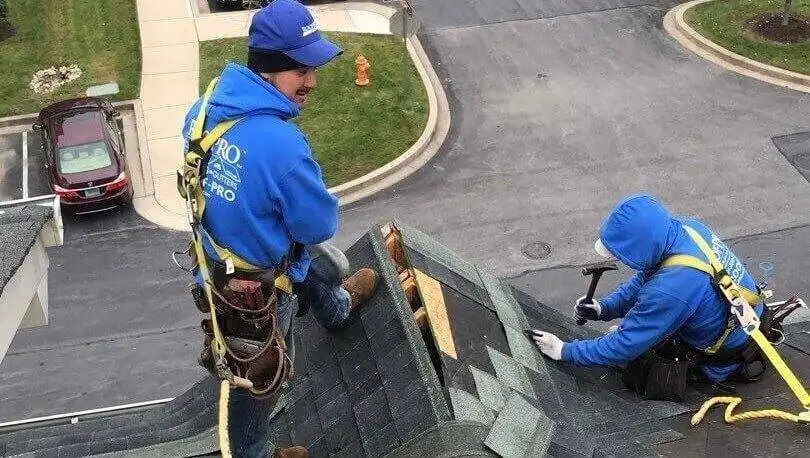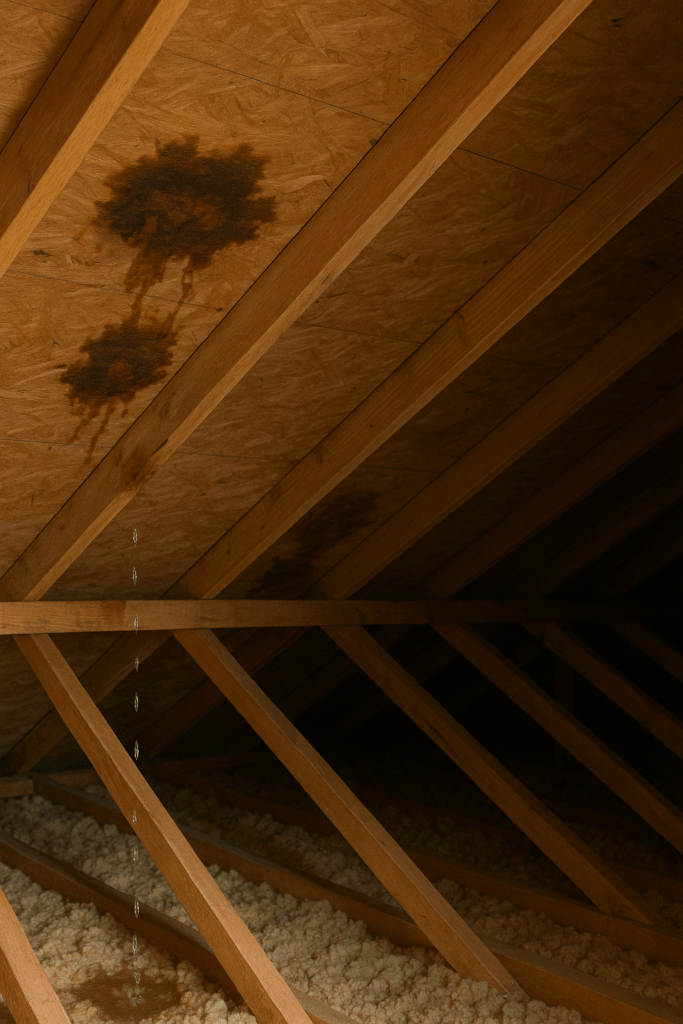If you’ve noticed stains on your ceiling, a musty odor upstairs, or damp insulation in your attic, chances are your home is dealing with a leak in the attic. Leaks are more common than many homeowners realize. Our experienced attic leak repair specialists have helped hundreds of Maryland homeowners find and stop leaks at the source before they turned into costly damage.
Let’s walk through the steps for what can cause an attic leak, how to spot the signs, what could happen if you wait too long, and how our team at RoofPro can help you get things fixed fast and right.

Signs You Have a Leak in Your Attic
Knowing what to look for can help you catch a leak early and trace it back to the source before it causes permanent damage.
Visual Red Flags
- Water stains or discoloration on attic beams. Circular brown marks on hallway ceilings start small and then expand after every heavy rain.
- Mold or dark spotting on insulation or rafters.
- Warped or damp plywood decking under the roof.
Smells and Sensory Clues
- A musty smell in the attic or upstairs hallway. The scent is earthy, similar to wet cardboard.
- Hearing the sound of dripping water during or after rainstorms.
Temperature and Air Quality Changes
- Unusual humidity or heat in upstairs rooms. A hidden attic leak raises household humidity.
- A spike in allergy symptoms (could mean mold growth nearby).
What Causes a Leak in the Attic?
Maryland homes face a mix of weather conditions that can test even the toughest roofs. Here are the most common leak sources we’ve seen in attics across the state:
Storm Damage
Hail, wind, or simple age can cause roofing material to loosen or fall off. Maryland’s freeze-thaw cycles expand and contract asphalt shingles. Over time, shingle tabs curl, granules wash away, and nails back out, creating pin-sized gaps. A single compromised shingle can create a direct path for water to seep beneath the roofing system and into the attic.
Flashing and Roof Details
Roof flashing is the thin metal that seals joints and edges across your roof. When it cracks, lifts, or separates, water can slip in around chimneys, vent stacks, or valleys. Old caulking or worn seals around skylights often worsen the problem, especially during heavy rain or melting snow. Over time, that trapped moisture can rot surrounding wood and insulation, turning a small issue into a costly repair.
Gutters and Ice
Gutters full of leaves can force water under the roof edge. Winter can be especially harsh. In winter, ice dams trap melting snow at your eaves, which backs up under a shingle roof and leaks into the attic.
Vents
Sometimes, it’s not an external leak at all. Poor ventilation causes humid air to collect in the attic, leading to moisture buildup. An attic needs steady airflow. Blocked soffit vents, an undersized ridge vent, or attic fans that dump humid air into the attic can all create this problem. When this moisture condenses on cold surfaces, it can mimic an exterior leak.
When the Air Conditioner (AC) Unit Is in the Attic
Air conditioner units can cause attic leaks when the unit isn’t draining properly. If the drain line clogs or the drip pan overflows, water can pool beneath the unit and soak into insulation or drywall. Over time, that moisture seeps through the ceiling, creating stains that often look like a roof leak.

How Much Does It Cost to Fix an Attic Leak in Maryland?
Minor repairs, such as replacing a handful of shingles and resealing a vent, typically cost between $300 and $600. Reworking flashing around a chimney or skylight can cost up to $1,500. Full decking replacement under a rotted valley, along with ceiling water damage repairs and water removal, can cost more than $3,000.
Two factors influence price most: the leak’s location and the extent of hidden damage. Our inspectors at RoofPRO will use photos and moisture readings to illustrate those details.
Is It Worth It To Fix Your Leak Now?
Moisture moves fast once it gains a foothold. Within 48 hours, mold spores can appear on wood and paper backing. Left untreated, they may release allergens that aggravate asthma. Water also softens trusses, reduces their load capacity, and weakens the overall structural integrity of your roof system. Electrical wiring that runs across damp wood risks short circuits. Insurance adjusters often reduce coverage when they see long-term water damage that was never addressed. Catching a leak early and repairing it quickly keeps your house protected and repair bills low.
Prevention Tips for Maryland Homeowners
Preventing attic leaks starts with regular inspections and good maintenance. Every spring and fall, climb into your attic with a flashlight and look for signs of moisture (dark stains on rafters, wet insulation, or mold damage). Pay close attention around pipes, chimneys, and skylights; those are common trouble spots where flashing can crack or shift.
Good airflow is your next line of defense. Make sure the soffit along the eaves and ridge vents at the peak of your roof are clear of debris. That airflow helps moisture escape instead of condensing on joists or rafters. If you notice cold spots in winter or feel drafts in summer, adding baffles to keep insulation from blocking the soffit can make a big difference. Finally, keep gutters and downspouts clean so that rainwater flows away from your foundation rather than seeping under roofing materials and entering the attic.
How RoofPRO Identifies the Source and Fixes Attic Leaks
At RoofPro, we approach every attic leak like a forensic investigation—methodical, accurate, and focused on long-term repair.
- Step 1 – Attic and Roof Inspection: We inspect both the ventilation in your attic and the condition of your roof. Outside, we check for damaged shingles, flashing, and valleys. Inside, we follow water trails, look for mold, and assess insulation damage.
- Step 2 – Moisture Detection and Mapping: Using moisture meters and thermal cameras, we identify damp spots invisible to the naked eye. This helps pinpoint the leak’s origin and scope.
- Step 3 – Pinpointing the Source of the Leak: Whether it’s around a vent, near the chimney, or at a ridge, we trace water paths to the root cause, not just the wet spots.
- Step 4 – Immediate Leak Repairs: If your leak is active during the inspection, we install temporary patches or tarps to stop further damage. We repair the roofing material, flashing, and underlayment. We also replace any damaged insulation or woodwork.
- Step 5 – Preventive Solutions:
If the cause was internal, like poor ventilation, we install attic fans or ridge vents to improve airflow and prevent future issues.

Get Help With Your Attic Concerns Today
Since 2004, our team has fixed everything from flashing leaks to full attic restoration. We bring proven experience to every project. Don’t let a small leak turn into a major repair bill. If you’ve noticed stains, smells, or signs of water in your attic, let the experts at RoofPro help. Our team is certified by leading manufactures like Owens Corning and maintain an A+ rating with the BBB.
Call us or send us a message to schedule your free inspection. We’ll find the source of the problem and deliver a solution that protects your home and your peace of mind.
Frequently Asked Questions
Condensation forms from indoor moisture and temperature differences, while a roof leak involves external water penetration.
Attic condensation tends to be uniform and appears across large surfaces. Roof leaks show up in patches or streaks, often near specific entry points.
Yes. Mold needs moisture, organic material, and mild temperature. Attic wood supplies all three. Removing water stops growth before spores spread.
You could try, but we advise against it. Quick DIY patches sometimes help during a storm. Leaks often travel far from their origin. Missing one spot could lead to continued damage. Plus, climbing on the roof is risky without the right safety gear.
Article Updated November 2, 2025.

Author Bio
Tim Taylor – Owner & Founder of RoofPRO
Tim Taylor began his roofing career in 2003 and founded RoofPRO in 2004 with a mission to fix the poor workmanship that often causes roof leaks. With over 20 years of hands-on experience, he’s earned elite credentials like CertainTeed’s ShingleMaster Wizard certification, HAAG inspection certifications, and OSHA safety training. His expertise in leak repair, flashing repair, and post-storm restoration has made RoofPRO one of Maryland’s most trusted roofing companies. Tim continues to lead with the same principle that built his reputation—roof it right the first time.


